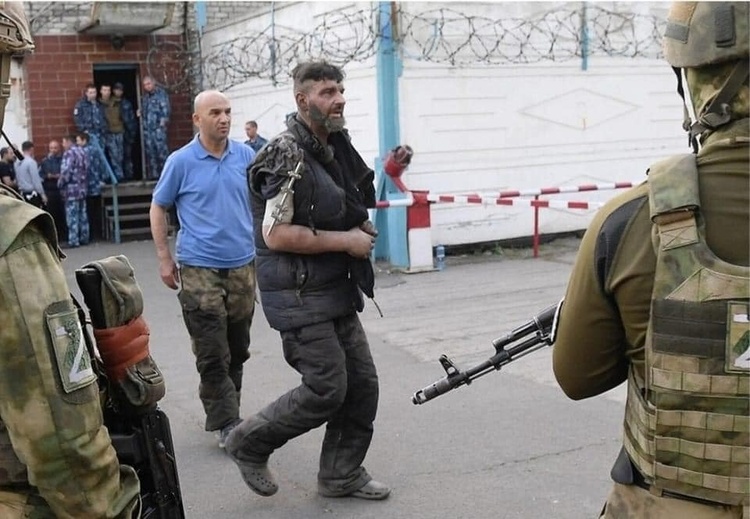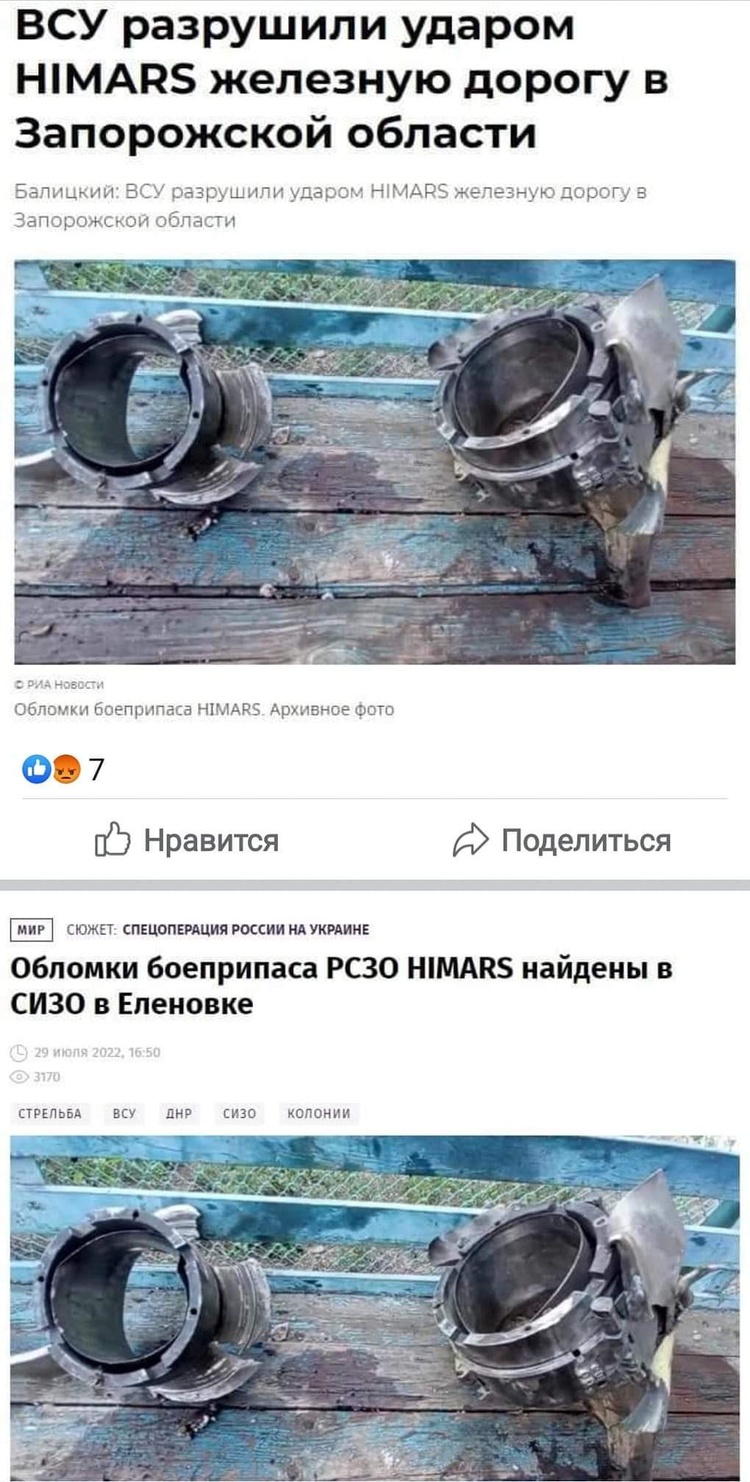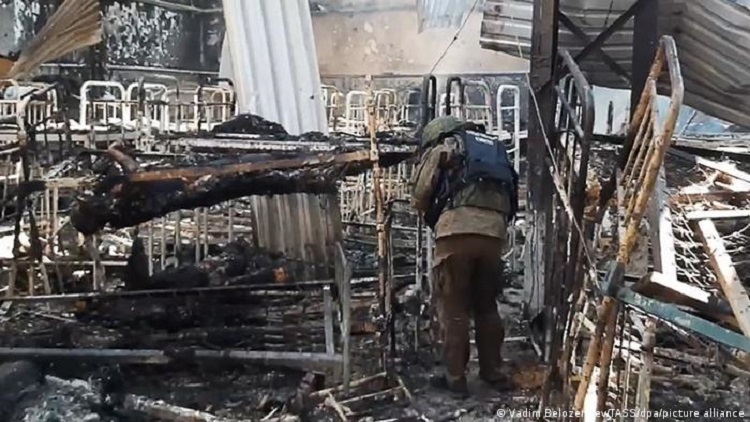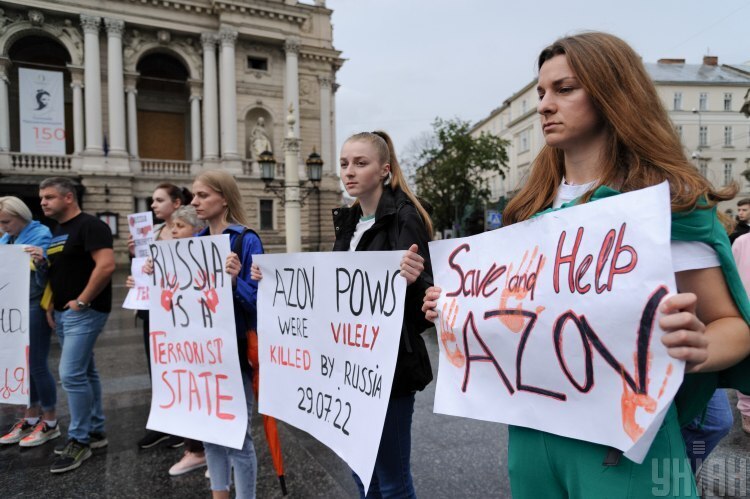Olenivka-2022: why “Ukrainian Katyn” became possible in ХХІ century
Are international institutions able to protect humanitarian law?
The Independence Day of Ukraine can become the day of another provocation by the russians and the demonstrative execution of captured Ukrainian soldiers. A show "trial" is already being prepared for defenders of Azovstal plant who are in Russian captivity. According to the Main Intelligence Directorate of the Ministry of Defense of Ukraine, in order to "legitimize" the court, the enemies prepare specially trained "witnesses" and bring representatives of the ruscist media to the Mariupol Philharmonic.
Now the occupants are urgently refurbishing the surviving hall of the Philharmonic: iron cages are being installed on the stage, in which Ukrainian defenders will be kept. Also, several new temporary structures are being built next to the premises. Ukrainian intelligence believes that Russia can launch a pinpoint missile attack on the Philharmonic and blame Ukrainians for the crime.
Meanwhile, approximately 1500 prisoners are currently held in Russian captivity – defenders of Mariupol, local doctors, rescuers and volunteers. Mind tried to figure out why the international community is powerless to free them despite numerous calls for active action, and how to affect Russia and bring it to trial for the inhumane treatment of prisoners.
How did the defenders of Azovstal and the people of Mariupol fight and survive?
The defenders of Mariupol held the defense and even counterattacked for 86 days – in complete encirclement, outnumbered almost 20 to 1 by the russians, under their absolute dominance in both air and artillery. It seemed that the Azovstal metallurgical giant was the last outpost of the city and turned into an unbreakable fortress.
But not only 2,500 defenders from various parts of the Ukrainian Army, the National Guard, border troops and patrol police found shelter in the basement of the plant, but also several thousand civilians. They were the families of military personnel and citizens of Mariupol, whose homes had been destroyed by bombing. According to the International Red Cross, from 4,000 to 8,000 non-combatants were at the same time in the basement of the plant.
For this reason, at the end of April, the garrison almost ran out of food and drinking water. As long as the spring rains continued, it was possible to accumulate water. Later – only night dew on the metal roofing. But with the rise of temperature in May, this option also disappeared.
Earlier the bunker hospital ran out of medicine, in particular, painkillers. Because of the high humidity in the shelter and the lack of ventilation, a significant number of severe injuries were accompanied by amputations due to the risk of gangrene. But the worst happened on April 28, when the russian Air Force dropped 1500-kg high-explosive bombs on Azovstal. The hospital was destroyed. The wounded patients and medical personnel died under the rubble, and the garrison was left without a critical supply of medicines and surgical equipment.
How did we try to save them?
The situation was getting hopeless. The chance of salvation was only through the procedure of "extraction" to a neutral party. Turkey was ready to take away the garrison by its ships and leave them on its territory until the end of the war, but the proposal was rejected by the russian army command. The best option remained to agree on the urgent evacuation of civilians.
Dozens of diplomats, heads of almost all religious denominations and celebrities were involved in the negotiation process. The call to save the garrison of Mariupol and civilians from Azovstal rang out even from the stage of the Eurovision finals.
UN Secretary General Antonio Guterres personally visited moscow and Kyiv on this occasion. As a result of this visit, a ceasefire was announced at the beginning of May and the evacuation of civilians from the territory of the plant began. Most of them, having overcome a dozen russian checkpoints and a humiliating "filtering" procedure, eventually ended up in the territory controlled by Ukraine. Some were stuck in filtration camps for "refugees" on the territory of the russian federation, and even their relatives have no connection with them.
How many Ukrainians from Azovstal were captured?
In mid-May, by order of President Zelensky, negotiations were held with the russian side regarding the withdrawal of the Mariupol garrison troops from the basements of Azovstal. The exact number of soldiers who laid down their arms and left is not known for sure.
The figures announced by the russian side do not inspire confidence. Russians often keep ordinary volunteers, such as the famous paramedic Yulia "Tayra" Payevska, and ordinary civilians suspected of "disloyalty" among prisoners of war.
According to sources, familiar with numbers, about a thousand soldiers of the National Guard Azov Detachment are in Russian captivity: two hundred marines of the 36th Brigade, part of which fought their way into the territory of the plant at the beginning of April for joint resistance (most of the marines died and got captured back in March), a little less than a hundred border guards, several dozen officers of the Mariupol patrol police, 82 medics of the 555th Military Hospital who refused to evacuate with civilians, a dozen rescuers of the Ministry of Emergency and medical volunteers of the "Hospitaliers" battalion, the “voice” of Azovstal Kateryna "Ptashka" (“the Bird”) in particular.
About one third of the garrison had moderate and severe injuries. Fifty of them were immediately transferred to the exchange pool through the mediation of the Red Cross. They were fighters with amputations and nonambulants. About 300 bodies of the dead were also handed over to the Ukrainian side – both military and civilian.
On May 20, the last to surrender to the prisoners were the head of Azov Denys "Redis" Prokopenko, his deputy Sviatoslav "Kalyna" Palamar and brigadier Serhiy "Volyna" Volynsky.
What else is known about captivity?
The captives were placed in several locations, to which representatives of international organizations were initially given access. These are prisons in Novoazovsk and Olenivka in the Donetsk Oblast and detention centers in Rostov Oblast of the russian federation. At the end of June, Ukrainians managed to exchange 144 POWs, of which 95 were the defenders of Azovstal.
Then the situation got out of control. Contacts with POWs by representatives of international organizations, who acted as mediators in the negotiations, were systematically sabotaged by the russian side. At the same time, hysteria broke out in russian mass media regarding the death penalty for captured warriors of Azov.
One of the mouthpieces of this hysteria was even the russian Embassy in London, which on its official Twitter page demanded that Azov citizens be executed by hanging.
In the end, the worst thing happened, as warned by those who were captured by Russia or had experience negotiating with the Russians on humanitarian issues. In fact, several dozen Azov soldiers were executed in Olenivka prison. According to Russian data, 53 prisoners died, almost a hundred received critical injuries and burns. There are still no data from international institutions.

What happened in Olenivka?
On the night of July 28-29, an explosion of unknown origin burst in one of the barracks of the Olenivka prison camp. About 150 captured Azov soldiers were transferred there only two days before. It was one of the technical barracks of the former penal colony, decommissioned more than 10 years ago.
There were bunk metal beds in a large room without internal ceilings. Nothing is known about the conditions of detention of the prisoners, since the International Red Cross has had no access to the prisoners since mid-June.
According to the Russian side, a missile of the HIMARS system hit the colony, with the aim of destroying Ukrainian prisoners who agreed to cooperate with the occupation administration and began to testify about the crimes of the "Kyiv regime" against the "people of Donbas".
But, according to the admission of the russian side, none of the guards and employees of the colony were injured – this was stated by the "human rights commissioner" of the pro-Russian administration.
The occupiers refused to return the bodies of at least 53 dead to the Ukrainian side at the request of the Red Cross, as well as to allow its representatives to visit the place of the tragedy.
The version of the russian side turned out to be so wrong that it was refuted by almost all analysts and Western media based only on satellite photos and fragments of the video distributed by the russians.
As expected, no impact craters from the HIMARS missile were detected in the video. Later the russian mass media used a photo of the wreckage of the rocket, which had already been published earlier.
What's more, all the metal beds remained in their places, partly with the remains of charred bodies, which is impossible in the case of a rocket or any long-range artillery projectile that provokes a powerful explosive wave.

Explosion experts and criminologists from different countries independently came to the conclusion that the explosion occurred as a result of detonation from the inside. It is most likely a thermobaric projectile that caused a zone of high temperature, and not a destructive debris effect.

In such a case, it’s nothing but a war crime. The kremlin more clearly shaped a public opinion within russia, which hysterically demanded demonstrative punishment for the Azov POWs, but not their exchange for russians.
What is the position of international mediators?
The Geneva office of the International Committee of the Red Cross (ICRC) acted as the subject of multilateral agreements regarding the assembly of weapons by Mariupol garrison fighters and their further exchange. After the tragedy in Olenivka, the ICRC stated that the organization does not guarantee the safety of prisoners of war after they fall into the hands of the opposing side, saying this is outside the organization's mandate.
Quick reminder: The International Committee of the Red Cross (ICRC) was founded in 1863 as a private initiative to take care of the protection of victims of armed conflicts and monitoring the observance of humanitarian law defined by the Geneva Conventions. The institution has repeatedly won the Nobel Peace Prize, in particular in 1917 – for protecting the rights of prisoners of war.
There are numerous regional franchises of the Red Cross in the world, in particular the russian one, created under the FSB’s umbrella to spread propagandistic narratives of "internal" consumption, such as the care about Ukrainian "refugees" (actually, victims of deportation).
"International humanitarian law clearly shows that prisoners of war, their lives, health and normal stay should be the responsibility of the holding party," the ICRC said, referring to the Third Geneva Convention.
This interpretation was tried to be disputed by the adviser of the Office of the President of Ukraine, Mykhailo Podoliak, a member of the contact group from the first days of the war, who is, obviously, somehow involved in the negotiations regarding the fate of the Mariupol garrison.
"The Red Cross must take care of the observance of the rules of the Geneva Convention regarding prisoners of war – both here and in russian captivity. Check the facts of torture, the provision of medicines, food products, the conditions in which people are kept, etc. That looks like a guarantee," he said on the radio.
"As a neutral intermediary, we facilitated the safe exit of combatants from Azovstal, interacting with the parties to the conflict. Further, only the russian side is responsible for them – according to the Geneva Conventions," ICRC spokesman Oleksandr Vlasenko responded to Podolyak's remark.
The Red Cross offered to hand over for free to the Russian side medicines, protective equipment and materials for carrying out forensic medical examination of the bodies of the victims, as well as to visit the scene of the tragedy. However, as of August 17, this proposal remained unanswered.
Ukrainian volunteer Andrii M., who was in Olenivka for a month and a half in mid-May, recalls that representatives of the Red Cross were indeed brought there once: "They were quickly taken to some room, in the yard they gave a briefing to the russian media and left. They did not visit us, although the imprisonment of non-combatants, who should rather be assessed as illegally detained, should have been one of the focuses of their attention," he said on conditions of anonymity.
What is the position of Azov fighters’ families and Ukrainian human rights defenders?
Viktoriya Solodukhina, an activist of the Association of Relatives of Missing Persons, believes that modern humanitarian law in this war is simply "dying in limbo before the eyes of the whole world".
"The Red Cross has not yet reported how many people have died, how many are in hospitals on uncontrolled territory and how they will return the bodies. We were promised that the boys would be returned alive, but they did not keep their promises," says Sandra Krotevych, sister of the Head of Azov staff, Bohdan "Tavra" Krotevych.
"The ICRC does not explain this process to relatives in any way, does not provide any feedback. They explain this by the fact that they do not have enough workers for so many of us," says Alla Samoilenko, the mother of the captured Azov officer Ilia Samoilenko.

No less critics went to the organization of negotiations with the russian side, which had to be managed by the Office of the President, in particular – by the Deputy Prime Minister for the Reintegration of the Occupied Territories, Iryna Vereshchuk.
"After July 29, I didn't hear that Vereshchuk, fulfilling the guarantee agreement, demanded that the signatory parties take responsibility for the broken agreements. I have not heard the speech of a single official who would accuse Russia, the UN or the ICRC of not fulfilling their obligations," says Solodukhina.
Vereshchuk's office refused to comment, referring to the busy schedule of the Deputy Prime Minister.
"There is no feedback from anyone. SBU, GUR, Ministry of Defense, all authorized, the Interior Ministry – not a sound. All they do is methodically collect information, and then it's empty," says the mother of one of the Azov POWs on condition of anonymity.
For a long time, the Deputy Minister of Defense of Ukraine, Hanna Maliar, insisted on maintaining silence in the media regarding the fate of the Ukrainian prisoners.
"She personally asked all relatives of prisoners to refrain from publicity, not to give interviews to media, not to go to independent human rights organizations, because they keep everything under control. However, after the mass murder in Olenivka, it became clear that they are far from keeping the things under control," says Ukrainian political analyst Maryna Danyliuk-Yarmolayeva.
The recently appointed Ukrainian Commissioner for Human Rights, Dmytro Lubinets, tried to calm the public, assuring them that silence does not mean that work is not being done, because, according to him, "silence must last until the release of the last Ukrainian defender."
What was behind the execution?
On August 1, General Prosecutor of Ukraine Andriy Kostin reported that, according to preliminary findings, the cause of the explosion could have been a thermobaric weapon, but not rocket fire, as the Russian side assures.
The Main Directorate of Intelligence of the Ministry of Defense of Ukraine stated that the Russians purposely killed the POWs in order to hide the tortures used to get "testimony". For this purpose, the fighters of the "Wagner" PMC (Private military contractor) bombarded the place of detention with the highly flammable substance, which led to an instant explosion in the barracks.
"The demonstrative execution of the Azov fighters was aimed at inciting the indignation of Ukrainian citizens at the actions of the authorities – in particular, the Office of the President, which actually gave the order to the Mariupol garrison to assemble weapons," – says Yevhen Magda, director of the Institute of World Politics.
UN Secretary General Guterres said that he will send a mission to get the facts regarding the death of Ukrainian POWs in Olenivka.
Will such a mission be effective? Unfortunately, there are reasons to doubt.
Widely known, that ICRC carried out a similar mission to the Theresienstadt concentration camp in the occupied Czech Republic in 1944. The result was a report that "the conditions for the Jews there are almost normal".
How could international humanitarian law work?
Zakhar Tropin, associate professor of international law at Kyiv National University, believes that the mandatory application of humanitarian law requirements to any combatants should be ensured by the parties to the conflict by default. The presence in the negotiations of such organizations as the UN and the ICRC guarantees this.
"However, and that’s strange enough, the ICRC has not yet issued any statement regarding Russia's violation of international law. Even because of non-admission of his representatives to the place of detention of prisoners in Olenivka, which is definitely provided for by the Geneva Conventions," Tropin summarizes.
The system of security levers operated by the UN appears to be even less effective in the conditions of clear sabotage of humanitarian law. The main reason is that legal structures are based on the presumption of unconditional observance of the international principles defined in the UN Charter, notes Oleksandra Matviychuk, head of the board at the Center for Civil Liberties.
"The design of the system does not take into account the situation when members of the UN Security Council demonstrably ignore international law and monitoring mechanisms. The possibility of coercion against Russia as a key player in the system is blocked. And we found ourselves in a situation where the entire UN system cannot extract even one person from Russian captivity. Without a radical reform of the international peace and security system, it is almost impossible to prevent such tragedies," says Matviychuk.
According to public statements, the head of the UN Human Rights Monitoring Mission, Matilda Bogner, and her colleagues do not have direct access to Olenivka. Instead, all information is received from the russian side and their "proxies" – for example, the "ombudsman of the DPR" (the same person who stated that, despite the missile hitting the colony building where the POWs were kept, not a single guard was injured).
What levers can be effective?
"Russia does not comply with international norms, but at the same time sits at the same table with the civilized world. This is unacceptable and cynical," says Iryna Novosiadlo, mother of one of the captured defenders of Azovstal.
Human rights activists are convinced that in order to ensure the safety of prisoners, levers that will be activated automatically in the event of a violation of humanitarian law by anyone are needed. For example, fines that can be applied by ICRC in accordance with its charter.
"No access to prisoners – report, fine. Prisoners are beaten, hungry – report, fine. Penalties for violations of humanitarian norms may be imposed by individual countries that allocate funds to the ICRC. It will be effective," Viktoriya Solodukhina believes.
Perhaps there are other tools for punishing those who ignore the norms of international humanitarian law. But the system really needs to be fundamentally changed. Otherwise, the mobile crematoria that Russia tried to use in Mariupol in the 21st century will soon turn into the infamous gas chambers from the experience of the previous war of the 20th century.
At least we are already watching the Ukrainian Katyn. Moreover, in the same ideological robes as during the Stalin Era.